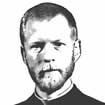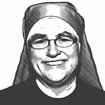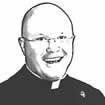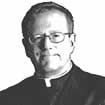
Culture

Lester
On Dec. 10, 1833, Father Constantine Lee wrote to Bishop Benedict Fenwick of Boston from Dover, New Hampshire, "under very disagreeable circumstances."
Father Lee had arrived in Boston with a recommendation from the Bishop of Edinburgh, Scotland, and his services were accepted by Bishop Fenwick on Aug. 2, 1833. The following month, he was assigned to the Dover station, which served Catholics in a large area: from southern Maine in the north, to Newburyport, Massachusetts, in the south.
Father Lee opens his letter referencing a letter of introduction provided by the bishop, which he carried to Dover and read aloud to the congregation. The contents let the Catholics in the area know that Father Lee was their new priest, and to support him in his work, "but still the lever of malice fermented high in spite of my feeble exertions," he writes.
He reveals a controversy over pews, specifically where members of the congregation were assigned to sit when they attended Mass. He attempted to resolve the problem by calling all members of the congregation for a meeting at the church and reseated them "according to their pay," but some did not attend and refused to relinquish their seats to those who did. In protest, the following Sunday, those aggrieved members of the congregation departed before his sermon was delivered.
He continues, revealing he informed the discontented parishioners that "public scandal in the church required public satisfaction," and that he would write the bishop to determine what their punishment should be. He delayed writing a week, during which two of the four offenders, whom he names, apologized for their actions and would accept any punishment the bishop recommended.
The root of the problem, he writes, "is a party with which they are connected, that is endeavoring to sow the seeds of discord in this Congregation." A faction within the parish felt that he favored certain other members of the congregation, claims he denies. Nonetheless, although he believes Catholicism will thrive in the area, he will resign his station at the close of the year so that Bishop Fenwick "can send them a Clergyman better calculated to humour their tempers." He also hopes that the bishop will find another station for him in the diocese, as he wishes to continue serving him, but if there is no station available asks to recommend him to another bishop.
Father Lee appears to have briefly attended a mission in Canton, Massachusetts, which served Catholics in the Blue Hills area. Mass was celebrated in the "Stone Factory Chapel" or an Episcopal church, which was rented from that congregation every other Sunday.
In April 1834, he was once again reassigned, this time to Providence, Rhode Island. The city was amid a spell of rapid growth due to the availability of jobs on the new railroad and the industries that followed. In 1832, there had been 200 Catholics in the city, by 1838 there would be 1,500, and it was Bishop Fenwick's desire to build a church there worthy of the state capital.
Much like Dover, the Catholic community in Providence was fractious, and obtaining financial support was proving difficult. By the time Father Lee arrived, all his predecessors were able to accomplish towards this goal was the purchase of a piece of land for the future church.
Diocesan historians, when characterizing Father Lee, reveal that he was well educated, having studied in Rome and earning a doctorate of theology, "blessed with learning, talents, eloquence, and piety; but the ability to raise money, to pay his debts promptly, and to handle unruly people seems to have been denied him." This was evident in Dover, and though he achieved the milestone of laying a cornerstone for the new church in September 1836, the project soon stalled due to lack of finances. The congregation began to lose their patience with him, as did several unpaid workers who threatened to undo all the work they had completed thus far, and he continually appealed to Bishop Fenwick for funds.
The situation escalated in May 1837, when the episcopal register references complaints against Father Lee, and his involvement in a trial over slander. Bishop Fenwick sent a priest from Boston to assess the situation and, upon his return, Father Lee's faculties were temporarily withdrawn, and he was recalled to Boston. Though he may not have possessed the skills necessary for this assignment, we should not underestimate the task he faced in Providence, his immediate successor would not last more than three months in the same role.
Father Lee would continue to serve the diocese for several more years in a mission that included an area encompassing Newport and Pawtucket, Rhode Island; New Bedford, Wareham, and Sandwich, Massachusetts. There were signs once again that, even though his mission covered a large area, he was struggling to raise enough money even to support his existence. He was granted an exeat on March 19, 1839, allowing him to depart the diocese.
He would venture west, stopping in Illinois, and then continuing to Canada, where he successfully served as pastor of the Cathedral of St. Catharine of Alexandria, Ontario. He remained there until his death in 1842, which was precipitated by pneumonia contracted while traveling in the rain to give last rites to a laborer working on the Welland Canal.
- Thomas Lester is the archivist of the Archdiocese of Boston.
Recent articles in the Culture & Events section
-
Building a legacyMichael Reardon
-
Scripture Reflection for Nov. 24, 2024, Solemnity of Our Lord Jesus Christ, King of the UniverseDeacon Greg Kandra
-
Seeds of graceMolly M. Wade
-
The dedication of St. Francis Chapel in the Prudential CenterThomas Lester
-
Honeybees are taking over for canariesDeacon Timothy Donohue


















